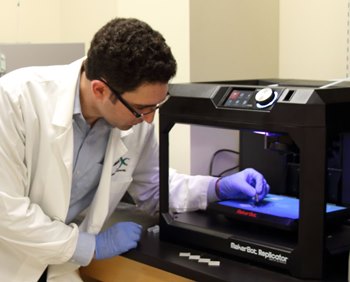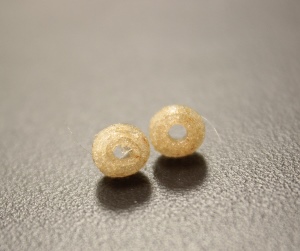NEWS
Louisiana Tech researchers use 3D printers to create custom medical implants
– Breakthrough technology creates materials infused with cancer-fighting drugs, antibiotics –
A team of researchers at Louisiana Tech University has developed an innovative method for using affordable, consumer-grade 3D printers and materials to fabricate custom medical implants that can contain antibacterial and chemotherapeutic compounds for targeted drug delivery.
The team comprised of doctoral students and research faculty from Louisiana Tech’s biomedical engineering and nanosystems engineering programs collaborated to create filament extruders that can make medical-quality 3D printing filaments. Creating these filaments, which have specialized properties for drug delivery, is a new concept that can result in smart drug delivering medical implants or catheters.
“After identifying the usefulness of the 3D printers, we realized there was an opportunity for rapid prototyping using this fabrication method,” said Jeffery Weisman, a doctoral student in Louisiana Tech’s biomedical engineering program. “Through the addition of nanoparticles and/or other additives, this technology becomes much more viable using a common 3D printing material that is already biocompatible. The material can be loaded with antibiotics or other medicinal compounds, and the implant can be naturally broken down by the body over time.”
According to Weisman, personalized medicine and patient specific medication regiments is a current trend in healthcare. He says this new method of creating medically compatible 3D printing filaments will offer hospital pharmacists and physicians a novel way to deliver drugs and treat illness.
“One of the greatest benefits of this technology is that it can be done using any consumer printer and can be used anywhere in the world,” Weisman said.
Weisman, who works out of a lab directed by Dr. David K. Mills, professor of biological sciences and biomedical engineering, partnered with Connor Nicholson, a doctoral candidate in nanosystems engineering and member of a lab operated by Dr. Chester Wilson, associate professor of electrical and nanosystems engineering, to develop the technology in collaboration with Mills. The group also worked with Extrusionbot, LLC of Phoenix, Arizona, who provided important materials support throughout the development and testing process.
“We had been working on several applications of 3D printing,” said Mills. “Several students in my lab including Jeff and Connor, who was a guest researcher from Dr. Wilson’s lab, had been working with colleagues for some time. I sent an email to them and asked them the question, ‘Do you think it would be possible to print antibiotic beads using some kind of PMMA or other absorbable material?’”
From that point, the technology evolved and has become a highly innovative approach to overcoming many of the limitations encountered in current drug delivery systems. Most of today’s antibiotic implants, or “beads,” are made out of bone cements which have to be hand-mixed by a surgeon during a surgical procedure and contain toxic carcinogenic substances. These beads, which are actually a type of Plexiglas, do not break down in the body and require additional surgery for removal. Weisman and his team’s custom 3D print filaments can be made of bioplastics which can be resorbed by the body to avoid the need for additional surgery.
The nature of the 3D printing process developed at Louisiana Tech allows for the creation of partially hollow beads that provide for a greater surface area and increased drug delivery and control. Localized treatment with the 3D printed antibiotic beads also avoids large systemic drug dosages that are toxic and can cause damage to a patient’s liver and kidneys.
“Currently, embedding of additives in plastic requires industrial-scale facilities to ensure proper dispersion throughout the extruded plastic,” explains Mills. “Our method enables dispersion on a tabletop scale, allowing researchers to easily customize additives to the desired levels. There are not even any industrial processes for antibiotics or special drug delivery as injection molding currently focuses more on colorants and cosmetic properties.”
“It is truly novel and a worldwide first to be 3D printing custom devices with antibiotics and chemotherapeutics.”
The team said the environment at Louisiana Tech played a large role in this project making the progress it has, in a relatively short period of time. “The project has been able to advance to this point because of the support of and easy access to interdisciplinary facilities and outstanding faculty such as Drs. Mills, Wilson and [Dr. Mark] DeCoster,” said Weisman. “They and their labs have been crucial in taking cell culture and chemotherapeutic related aspects of this project to the next level”
“It is important to continue support of this research and to help bring Louisiana Tech to the forefront of rapid prototyping designs that will have impacts on a national scale.”

